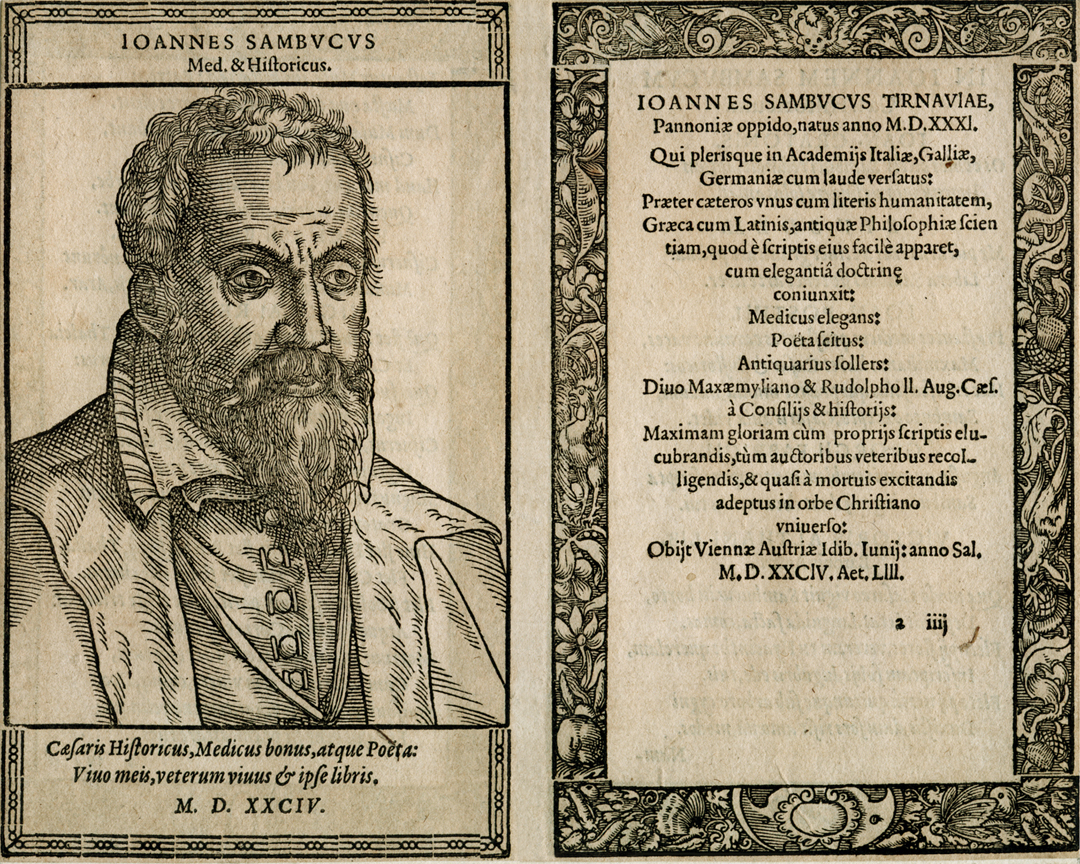
János Zsámboky (Nagyszombat, 1st July 1531 – Vienna, 13th June 1584), also called Sambucus, Hungarian humanist scientist, historiographer, royal medic, cartographer, polymath, linguist, philologist, councillor, collector, antiquarian, cartographer, numismatist, botanic, excellent writer of letters, editor of a famous emblem.
His father, a supporter of Ferdinand, the Catholic Péter Zsámboky moved from his lands near Zsámbok (which fell to the hands of the Szapolyai family), to Nagyszombat, and received nobility for his merits. János, when he was 11, began his 22-year-long study tour. He began his studies of Greek language in Vienna, under Georg Rietham. In 1543, he travelled to Leipzig, to Joachim Camerarius. In 1545, he became student of Melanchthon in Wittenberg. In 1547, his first work was published, titled Tabellae dialecticae in usum Hefflmari, which is only known from bibliographies. In 1548-49 he studied together with Veit Amerbach in Ingolstadt. In 1550, he was taught by Johannes Strum, and in the same year, two of his pedagogical works were published, his collection of Lucian and his explanations for the Iliad and the Odyssey. In 1551-52, student of Jean Dorat (Auratus). He acquired a Master’s Degree, and in September 1551, he gave a lecture titled Oratio quod oratores ante poetasa pueris cognoscendi sint. Here he acquired the first codices of his collection. He finished his bilingual work, titled Effortless Chatting, containing speeches of Xenophon and their translations to Latin, and in the appendix, he published his poems. In 1553, at the expense of Miklós Oláh, Archbishop of Esztergom, he continued his peregrination in Italy. Oláh escorted his nephew, György Bóna, to Padua, and here he also became the teacher of Miklós Istvánffy. At the request of Emperor Ferdinand, he translated Tinódi’s rhymed chronicle about the siege of Eger (1552) to Latin in a prosaic form. In 1555, in Padua, he acquired his medical license. He had his poems and Dialectica published. In 1557, he was awarded the title of familiaris aulae. At the request of the Emperor, he organized the manuscript collection of the University of Vienna. Meanwhile, he completed and published his story of Ransanus, with his translation of Tinódi in the appendix. From 1558, academic supervisor of Jacob Fugger. In 1560, he travelled to Paris again. After Christmas of 1561, he spent a few months with his friends in Antwerp, for example, with Cristophe Plantin, publisher of several of his works. In 1562-63, he was travelling in Italy, together with Petrus Victorius and the leader of the press of Vatican, Paulus Manutius. In Napoli, he bought several codices, and in 1563, he returned to the German lowlands. By the end of the year he had finished his famous Emblemata (Antwerp, 1564). In 1564, he returned to Vienna, and became royal poet, writer and medic of Maximilian. In 1567, he was named count of the Court, and from 1569, he was a member of the Imperial Council. During this time, he was organizing his collection of 3327 books, mostly written in either Greek or Latin. He informed his contemporaries about his manuscripts and made their publication possible. Today his extensive collection can be fount in the national library of Austria, the Österreichisches Nationalbibliothek.
He made a map of Hungary in 1566. His maps of Hungary and Transylvania are not original works, but copies of others’ works with additions and re-written explanations. Slovakian map historians know him as Ján Boza. (The explanation for this is that Zsámboky’s Latin name, Sambucus, means elderberry, which is called baza in Slovakian)
More than 50 of his works were published, almost forty of them are original works, including the first Hungarian book about medical history. He redacted the first full publication of Bonfini. He searched for all available works of Janus Pannonius in hopes of publishing his full life work. His goal was to draw attention to Greek culture, which, similarly to his master, Dorat, he found more interesting than Latin culture. He summarized his views on philology in his work De imitatione Ciceroniana. Conversations between him and his student, György Bóna, explain that while he finds Greek culture more original, his opinion of the Latin language is higher, because it is the best form of expression and the best tool for making “vulgar” languages nobler. Although he only wrote in Greek and Latin, he thought that protecting the Hungarian language is important. According to him, every language should be augmented with Latin, but each in their own ways. He also tried the art of letter writing. His Neo-Platonist and Aristotelian views of language and literary theory are summarized in his commentaries of Horatio. As first in the history of Hungarian literature, he thought of poetry as a separate discipline, although only in Latin. He created significant works in almost all fields of humanist art, but while he lived, he was mostly known as a poet, mainly because of his Emblemata. Its success was so great it was published five times, and translated to Dutch and French. In England, Geoffrey Whitney translated 50 of them in his Choice of Emblemes, what Shakespeare used as a source. Similarly to András Dudith, Zsámboky was an honoured member of the European humanist community, his house in Vienna was a meeting point of scientists.




